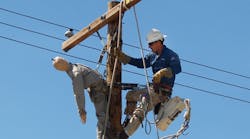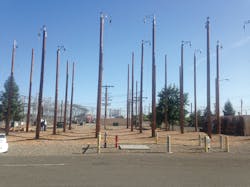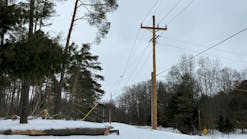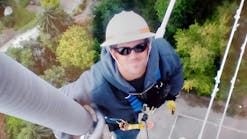As baby boomers prepare to retire from the industry, electric utilities are faced with the challenge of filling the veteran journeymen’s work boots with well-trained, safety-minded employees. By establishing a thorough training program and investing in the latest tools and equipment, utilities are helping to transform new apprentices into seasoned linemen.
For example, Sacramento Municipal Utility District (SMUD) runs a comprehensive and rigorous training program for its lineworkers. Rather than just focusing on training the new apprentices, the utility instead offers training to linemen throughout their careers.
Putting Candidates to the Test
SMUD’s training program begins with the initial hiring and testing process when an individual applies for an apprentice lineworker position. The candidate must pass a series of tests, which include a written test and a physical skills aptitude test. Upon passing the written test, the candidates are given a date to report to the utility’s skills training facility.
SMUD then tests the candidates’ strength by assessing their ability to pull a 10-ft heavy crossarm to the top of a 45-ft pole. The trainers instruct the candidates on how to set up and wear their climbing gear as well as how to climb a pole while in full fall protection.
The candidates must then climb and maneuver around a pole at 10 ft, 15 ft and 30 ft. For the final test, they must hang an 8-ft light crossarm with pin and glass at 30 ft. SMUD rates the successful candidates based on their ability to perform all of the skills. In addition, the utility considers the candidates’ attitude, behavior, confidence and ability to listen, take orders, follow instructions and communicate well with others. SMUD then places the successful candidates on an eligibility list for consideration for employment.
Training Apprentices
Once SMUD hires an individual, he or she enters the lineworker apprentice training program, which includes a 10-day climbing school. This school consists of rigging and general line work fundamentals, with the primary emphasis on climbing and working aloft. In order for the employee to pass, he or she must hang a set of 10-ft double heavy crossarms at 40 ft in 45 minutes.
Apprentices must then complete four years of on-the-job training, three years of night school, and a six-month (de-energized (cold) and live-line (hot) training assignment at the Hedge training facility. The apprenticeship program consists of eight six-month steps.
After successfully promoting through their first two steps, the cold apprenticea will then be promoted to the third step. At this point, the apprenticea will be reassigned to a crew for an intensive six-month lineworker general fundamentals course. This program will include rigging, transformer theory and application, line construction standards, and clearance and authorizations. In addition, the apprentices also must complete a course in electrical theory, personal protective grounding and live-line work before coming back to the yard as a “hot apprentice” and promoting into the fourth step.
From this point, the apprentice lineworker has to successfully pass a step test every six months in order to advance to the next step and be recommended to take the journeyman test.
Updating Journeymen’s Skills
Training for the line department does not end once an apprentice tops out as a journeyman. Instead, SMUD offers two full days of training to journeymen on an annual basis.
During the “bundled training,” SMUD pulls an entire crew from its daily work responsibilities so they all attend the session together. The line supervisor reassigns the work to other crews so that the crew in training can focus solely on successfully completing their annual training requirements.
Bundled training is a combination of classroom and field curriculum. The linemen must successfully perform pole-top and aerial lift rescues in a lab environment. Typically, the rest of the course takes place in the classroom. Two crews at a time are scheduled to attend training, including the fault locators, labor, and meter and service crews.
The journeymen then must complete two full days of training that includes the following modules: first aid/CPR, Smith System driving, and aerial lift rescue/pole-top rescue. In addition, they must complete training in fall protection, man down, rigging, fire safety, asbestos, and environmental compliance and awareness. Finally, SMUD trains the linemen on hazard communication, spill prevention control and counter measures, and access to employee exposure and medical records, blood-borne pathogens.
Not only do SMUD’s linemen focus on their apprenticeship and job-related training skills, but they also have additional training in cyber security, information and records privacy, NERC and FERC compliance, and critical infrastructure protection training.
In addition, when SMUD purchases new tools or technology for its field workforce, the utility invites vendors to show these new products to the line crews and familiarize them with new guidelines. If new equipment is being installed on the transmission and distribution system, as is the case with distribution automation, then the training department will work in conjunction with engineering and the manufacturer to provide training to both operations and the line department.
As the use of technology increases at SMUD, and other organizations see opportunities to provide services to customers, a highly trained and educated workforce is vital to enable the utility to compete in a dynamic business climate.
Max Fuentes ([email protected]) is the grid assets T&D line supervisor for business operations for the Sacramento Municipal Utility District (SMUD). He leads the overhead and underground line maintenance department. He joined SMUD in 1984 as a lineman and line foreman. He left in 1996 and pursued a career in training as the vice president of Northwest Lineman College and then as the president of Trade Tech in Sacramento, California. Fuentes returned to SMUD in 2002 as a lineman and transitioned into a supervisor position in 2004 in safety and training. He has been involved in the development of pole climbing, rigging, personal protective grounding and line work procedures as well as the near-miss policy.
Company mentioned:
Sacramento Municipal Utility District | www.smud.com
Sidebar: Six Keys to Recruiting and Retaining Lineworkers
Here are six ways a utility can create a training program that will ensure its linemen’s success — from their first day on the job though their last few years in the industry.
1. Organize a climbing school. Candidates may want to pursue a career in line work but lack the aptitude or the willingness to climb wood poles and other structures. Before investing a lot of time to train potential candidates, organize a prescreening to weed out any applicants who aren’t physically able to do the work.
2. Train apprentices in all facets of line work. By giving apprentices hands-on experiences in the field, they can successfully perform a wide range of line work once they top out as journeymen.
3. Provide continued education courses for journeymen. Try to offer training to journeymen at least once a year. Apprentices and veteran journeymen both can benefit from continuing education courses.
4. Educate line crews on how to use new tools. To ensure the maximum productivity and safety, train the field workforce on how to use new tools and technology before rolling them out to linemen.
5. Use a blend of external and internal resources to provide comprehensive training. When SMUD initiates new training, such as rubber gloving its 12/21-kV circuits, the utility brings in a contractor to provide the training. The utility then trains its own in-house trainers through a Train-the-Trainer program. For lineworker-specific skills training, the utility relies on its own linemen and foremen, while the company depends upon its corporate safety department to provide regulatory and compliance training. Additionally, cyber security, inclusion and district training is developed, maintained and rolled out through the departments that are specifically tasked with those responsibilities.
6. Offer online training resources. While it’s advantageous to offer in-person training sessions whenever possible, the field workforce can also benefit from online training programs. For example, at SMUD, the utility’s Learning Management System develops and maintains Web-based courses.
Sidebar: Inside SMUD’s Training Yard
At the Hedge training facility, lineworkers and substation and network electricians receive hands-on training for their specific job functions. Here are some of the features of the Hedge training yard in Sacramento, California.
• The training facility has a pole climbing orchard with fall protection installed. Field professionals can train on steel poles, transmission towers, and lattice and steel structures.
• In the facility’s general line work area, apprentices learn basic line work fundamentals, from installing and replacing poles to performing live-line training.
• The yard has an area for installing, removing and terminating distribution underground cable.
• Lineworkers also can learn how to perform long-line helicopter work in the training yard.
• In the indoor facility, SMUD has two classrooms with projectors and network interface for computers for online training through the company’s corporate learning management system.




